It’s the end of a busy morning and you’re just about to see your last patient before a well-deserved lunch. You walk in and the patient says, “Doctor, I have tears running down my left cheek all the time.”
Put lunch on hold.
For most doctors, epiphora may not be as daunting as the dreaded double vision complaint; however, determining the cause of epiphora can be stressful and time-consuming.
For whatever reason, many eye care providers dread or fear performing lacrimal dilation and irrigation, which often is essential to determine the cause of the patient’s epiphora.
Perhaps this is because it involves putting an extremely sharp, pointed metal object into the patient’s punctum. Or maybe it’s because you remember learning it in optometry school, but you haven’t performed it in quite a long time.
|
|
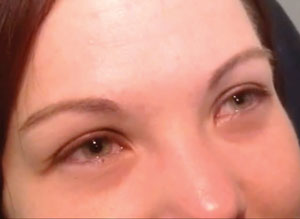
|
|
|
Epiphora has a number of possible causes. Determine the etiology in your patient’s case before considering lacrimal dilation and irrigation.
|
Fear not. It’s a relatively simple procedure that’s often indicated to treat or diagnose several common ocular conditions. The aim of lacrimal irrigation is straightforward: to open an obstructed tear duct and allow the tears to flow properly. This article—the third in a six-part, print-and-video, how-to series—explains how easily lacrimal dilation and irrigation can be done.
Know the Anatomy
Before performing lacrimal dilation and irrigation (D&I), be sure you understand the anatomy of the nasolacrimal drainage system. The puncta are the openings to the drainage system, with aperture sizes that vary from patient to patient. Both the superior and inferior punctum open into a superior and inferior canaliculus, respectively.
The canaliculus has a vertical portion that extends approximately 2mm in length before bending horizontally and running another 8mm in length nasally. The two canaliculi join at the common canaliculus just before entering into the nasolacrimal sac, which is located within a fossa in the medial orbital wall.
The nasolacrimal sac extends roughly 10mm before draining into the nasolacrimal duct, which is located within the maxillary bone. This extends to the inferior meatus of the nose and ends at the valve of Hasner. This valve prevents the backflow of fluid from the nasal cavity up into the duct.1
Causes of Epiphora
Potential causes of epiphora include:
- Lid appositional abnormalities—entropion, ectropion and floppy eyelid syndrome
- Ocular surface disorders— including trichiasis, abrasion, foreign body, dry eye syndrome and recurrent corneal erosion
- Obstructed tear flow tract— canalicular, punctal or nasolacrimal duct obstruction
- Infectious causes— canaliculitis and dacryocystitis
Nasolacrimal duct obstruction can be acquired, which is often due to aging, or the obstruction can be congenital. Infants may suffer from congenital obstruction of the nasolacrimal duct when the valve of Hasner fails to spontaneously open at birth. This resolves on its own in about 90% of cases before the child is one year old. So, it’s not usually recommended to perform dilation and irrigation on a child younger than one year.2
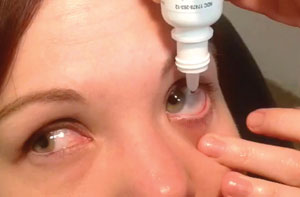
|
|
|
Lacrimal dilation and irrigation can be performed behind the slit lamp or outside of it. Once the patient is in position, apply a drop of topical anesthetic to the eye.
|
|
You must determine the underlying cause of the epiphora prior to considering lacrimal dilation and irrigation, as it’s not indicated in all of these cases. A diagnosis of dacryostenosis is typically considered after you rule out lid malposition and ocular surface disorders. Dry eye syndrome is usually the fallback diagnosis, but consider it only after exhausting other possibilities.
Be sure to perform a thorough slit lamp examination to determine if dilation and irrigation is indicated. If a patient complains of sudden-onset tearing and a painful eye upon waking, for instance, then the diagnosis and cause of the tearing is most likely a recurrent corneal erosion, and D&I is likely not needed.
Indications
Consider performing lacrimal dilation and irrigation when a patient has a complaint of epiphora and you suspect an obstruction in the nasolacrimal drainage system. Lacrimal irrigation is advised in canalicular obstruction, which often occurs from stenosis, mucous plugs or small stones in the tear ducts. In this case, the patient will exhibit epiphora, typically unilaterally, in a white and quiet eye.
Performing irrigation will either clear the obstruction or allow you to determine the location of the blockage. Depending on the cause and severity of the obstruction, a dacryocystorhinostomy (DCR) may be indicated.2
|
|
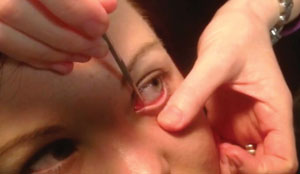
|
|
|
Pull the patient’s lid temporally and insert the dilator vertically approximately 1mm to 2mm into the punctum.
|
Thorough evaluation is also necessary to rule out infectious causes of epiphora, such as canaliculitis and dacryocystitis. In the case of canaliculitis, the puncta will be “pouting” (red and turning outward), and the surrounding area will be erythematous. With slight palpation, you’ll often be able to excrete mucopurulent discharge or concretions from the punctum. Treatment varies among clinicians; however, lacrimal irrigation with an antibiotic solution is a viable option to consider, as well as topical and/or oral antibiotics.
In cases of dacryocystitis, more swelling, tenderness and pain over the lacrimal sac will be observed. Don’t perform irrigation in the case of dacryocystitis; instead, prescribe oral antibiotic treatment, such as amoxicillin/clavulanate 500/125mg TID.2,3
Equipment
-
Lacrimal dilator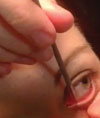
Roll the dilator between your thumb and index finger to acheive proper dilation. - 27- to 19-gauge cannula (depending on the patient’s punctum size)
- 3cc syringe
- 1cc to 3cc sterile saline
Get in Position
Lacrimal dilation and irrigation can be performed either behind or outside the slit lamp. A benefit of performing D&I outside the slit lamp is the easier accessibility to the patient and more freedom of movement; however, one of the downsides is not having the magnification the slit lamp offers. A benefit of performing D&I behind the slit lamp is that it allows you to more accurately assess the punctum with the increased magnification. The increased magnification enables you to better determine exactly where to place the dilator and the cannula.
We prefer performing dilation and irrigation outside the slit lamp with our patient reclined to a height that is comfortable for us to easily manipulate the punctum from above. Keep in mind, with her or his head reclined, the patient may experience a slight gag reflex when they taste the saline.
We also adjust the stand lamp so the light shines directly on the eye undergoing the procedure.
How to D&I
Before dilation and irrigation (D&I), numb the punctum for patient comfort.
- Apply proparacaine or another topical anesthetic to a cotton-tip applicator and gently rest it on the patient’s punctum for 30 to 60 seconds.
|
|
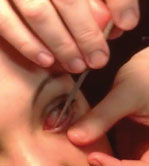 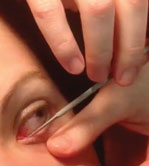
|
|
|
After sufficient vertical dilation, re-orient your dilator almost 90 degrees horizontally, all the while keeping your dilator in the patient’s punctum. Continue rolling and circling the dilator in the same manner.
|
|
|
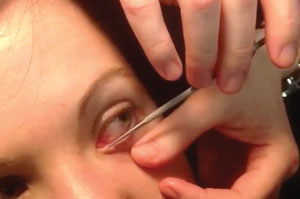
|
|
|
Once you’ve dilated the punctum enough for your cannula to comfortably fit, you know you’ve achieved sufficient dilation.
|
|
|
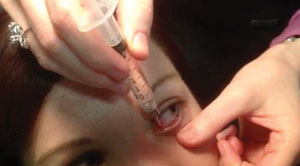
|
|
|
Next, remove the dilator and insert the cannula attached to the saline-filled syringe, in the same manner as the dilator: vertically 1mm to 2mm with the lid pulled temporally.
|
A drop of proparacaine into each eye also helps eliminate a blink reflex.
Once the patient is sufficiently numbed, begin the procedure.
- It’s a good idea to tell your patients to look “up and away” or “down and away” from the punctum being dilated, so they don’t become apprehensive at seeing the lacrimal dilator.
- Pull the patient’s lid temporally and insert the dilator approximately 1mm to 2mm vertically into the punctum. Start with the smaller end of the dilator and switch to the larger end once the punctum is sufficiently dilated.
- To achieve proper dilation, roll the dilator with your thumb and index finger or move it in a circular manner.
- After sufficient vertical dilation, re-orient your dilator almost 90 degrees horizontally, all the while keeping your dilator in the patient’s punctum, and continue in the same rolling or circular manner.
Once you’ve dilated the punctum enough for your cannula to comfortably fit, you know you’ve achieved sufficient dilation.
- After you’ve dilated the punctum, remove the dilator and insert the cannula attached to the saline-filled syringe. Insert the cannula in the same manner as the dilator; first vertically 1mm to 2mm with the lid pulled temporally, then re-orient it horizontally approximately 8mm. Take caution when moving the cannula horizontally and nasally; if you go too far, you’ll hit nasal bone and cause some discomfort for the patient.
- Gently press the plunger on the syringe to release the sterile saline into the patient’s lacrimal system.
Results
If the lacrimal system is open, the patient will feel or taste the salty saline in the back of his or her throat. With this result, the cause of the epiphora is likely not nasolacrimal duct obstruction.
If the lacrimal system is blocked, you’ll feel resistance of the plunger and see regurgitation of the saline. If regurgitation is coming out of the punctum being irrigated, then the blockage is proximal to the common canaliculus. If regurgitation happens in the opposite punctum, then the blockage is distal to the common canaliculus. Either way, further lacrimal probing is indicated.
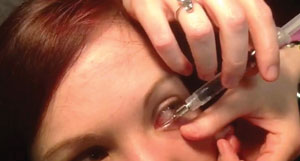
|
|
|
Now orient the cannula horizontally, then insert it further nasally into the canaliculus to approximately 8mm. Don’t go too far or you’ll hit nasal bone and cause discomfort for the patient. Gently press the plunger on the syringe to release the saline into the patient’s lacrimal system.
|
|
Or, you can attempt to remove the blockage, or move it farther down the lacrimal drainage system, by irrigating multiple times—you may need to irrigate more forcefully for this to occur.
If you are still unsuccessful after several attempts to move the blockage, refer the patient for lacrimal probing.
If, however, you are able to successfully move the blockage and the patient can taste or feel the saline, no further treatment is necessary—these patients generally do not need to be seen for follow-up.
Billing and Coding
A simple procedure code of 68810 (“Probing of nasolacrimal duct, with or without irrigation”) is used with a –LT or –RT modifier stating which punctum was dilated and irrigated. The ICD-9 diagnosis codes to accompany the procedure code may include epiphora (375.20), nasolacrimal duct obstruction (375.55) and nasolacrimal duct stenosis (375.56).
|
|
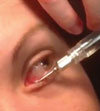
|
|
|
If the lacrimal system is open, the patient will feel or taste the saline. If the system is blocked, you’ll feel resistance and see regurgitation of the saline.
|
As with any patient, always document thoroughly. Include the patient’s symptoms, why you chose to dilate, how you performed the procedure and the results you achieved. Also document how the patient tolerated the procedure and when you expect them to return for follow-up.
As you can see, lacrimal D&I is actually a simple procedure to perform and needn’t be dreaded or avoided when clinically indicated. Knowing the anatomy of the nasolacrimal drainage system well will remind you of the proper placement and movement of the dilator and cannula.
When performed correctly, this quick procedure helps your patients stop crying, gets them smiling again and gets you on your way to an enjoyable lunch.
Dr. Provence-Perry is currently completing an ocular disease and family practice residency, with an emphasis in disease management and anterior segment laser procedures, at Northeastern State University Oklahoma College of Optometry. Dr. Smith is currently completing a residency in vision rehabilitation: low vision and neuro-optometry at NSU Oklahoma College of Optometry. Dr. Lighthizer is the assistant dean for clinical care services, director of continuing education, and chief of both the specialty care clinic and the electrodiagnostics clinic at NSU Oklahoma College of Optometry.
1. Remington LA. Nasolacrimal drainage system. In: Clinical Anatomy of the Visual System. 2nd ed. Philadelphia: Elsevier; 2005: 173-4.2. Canaliculitis. In: Gerstenblith AT, Rabinowitz MP, eds. The Wills Eye Manual: Office and Emergency Room Diagnosis and Treatment of Eye Disease. 6th ed. Philadelphia: Lippincott Williams & Wilkins; 2012:143-6.
3. Hurwitz JJ. The lacrimal drainage system. In: Yanoff M, Duker JS. Ophthalmology. 3rd ed. London: Mosby Elsevier; 2009: 1482-7.

